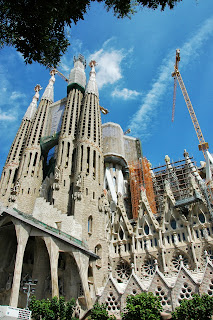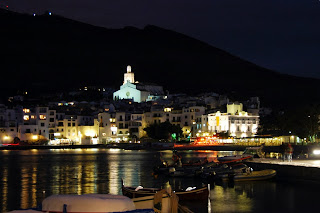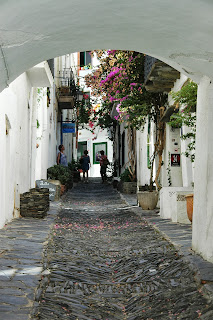We had not been to Barcelona (well I had as a teenager which
was a little time ago and does not count). After our Madrid experience we
decided to start off with a topless bus tour.
Earphones are supplied for the commentary and the Spaniards have started
their own sculptures when they get off (no
other nation would do this!!).
We got half way round the red route and decided to hop off
at the Museu Nacional d’Art de Catalunya. This imposing building overlooks the
city and rewards tackling the stairs with great views.
By
walking further on and up a trip to the top to the Castell de Montjuic could be
undertaken by chairlift or Funicular. We opted for the former and were rewarded
by the first that I have travelled on with a 90° turn.
We were now well above the Art museum.

The view of the harbour underscored how massive the port is
– this is barely one half…
Mind you the cost of construction is met by port fees which are rigorously enforced.
Looking inland towards the City the Sogroda Familia stood
out which was our first appreciation of Gaudi’s work.
On return to the City we visited “La Pedrera” Espai Gaudi.
This famous building was fascinating.
As the light changed so did the façade with its individually
unique wrought iron balconies.
A visit was compulsory and included a trip to
the roof to see the chimneys and water towers.
There were various ideas of what the chimneys looked like
ranging from Bedouin woman to something out of Star Wars (a light coloured
Darth Vader?). Being able to see through the vents gives the impression of eyes
and being watched.
Not only are they individually remarkable they add to the effect
of the atrium (are they guarding or peering in?)
One level down we were allowed to explore the attic. This
from my perspective really underscored the genius of Gaudi and his ability for
complex maths. None of the supporting arches was the same and all looked like
they were on the limits of brick arches – however they have passed the test of
time.
Across the road was another Gaudi building called Casa Batlló.
The façade was quite different but continued the use of
curves and each balcony being individual.
In the evening when lit up it was even more impressive as well as extremely colourful.
The following day we opted for the blue bus route and parked
near Sogroda Familia. This cathedral sized church was still being built,
apparently from Gaudi’s plans. It is paid for by visitors which were queued the
length of the building (and this was shoulder season). We did not go in but I
can just imagine arranging a tour of an Australian building whilst construction
was underway! That said even from
outside the building was incredible. The towers may look the same but they are
all different.
Similarly the side of the church had four windows – but look
closely and they all have different details.
This is the top of two of the (ultimately) 16 spires.
Jo had seen in a brochure a picture of the glass ceiling of
the Palau de la Musica Catalana – so off we went for a walk across several
blocks. What could be undertaken in half an hour took well over double that due
to the girl’s automatic slow gear as we passed numerous shops. We managed to
join the last English speaking tour of the day (albeit we had to ask the
doorman if we were allowed to catch up after the sales girl had told us this
was impossible and sold us tickets for the later Spanish tour). The interior was
wonderful and very colourful. The building uses four main materials – glass,
iron, ceramics and terracotta. The architect Lluis Domenech i Montaner, designed an iron clad structure which only took 3 years to construct (remarkable for its time - 1908).
The ceiling centrepiece was particularly detailed and became mesmerising when the large organ was turned onto to play Bach's very moving Organ Toccata.
After all the walking it was good to get on the bus as we
headed to the hills and went into the Park Güell. The first item to greet us was the famous gecko (OK
dragon). Happy Snappers were in abundance and with their pre-occupation of
being photographed in front of whatever they are visiting the poor gecko was
constantly draped with bodies and impossible to photograph on its own. That was
until Principal Helen stepped in and enabled this shot. (You cannot see all the
ashen wannabee models fleeing off camera.)
The seats surrounding the park arena were very popular, but
I did wonder how many appreciated they were sitting over voids.
Barcelona has a rival to the gherkin – the torpedo. This is
quite impressive at night when all lit up. We drove past on our way home on
both evenings but despite driving at 5kph with other drivers hooting and
swerving past us the passenger photographers in our car failed to get a shot
good enough for this blog.
The initial plan had been to use the caravan site as a base to also visit Andorra but after
the pace of the Barcelona days we opted for a quieter trip to Cadaqués, the
home of Salvador Dali. We arrived at 16:00 with no previous appreciation of how
beautiful the town is. The team voted that we should seek out a hotel and spend
the night so we could have dinner with wine and enjoy the ambience. We agreed,
as we had no change of clothes or toothbrushes (they were back in the ‘van) that
no one was to complain if the following
morning travelling in the car was a bit rank. The town is stunning with its
white washed buildings and numerous small boats.
We selected one of the many restaurants overlooking the water and once the chef (and owner) took our order he produced one of the best spaghettis (with fresh clam sauce) I have ever had. We felt obliged to follow the two bottles of wine up with further cocktails and in my case a Chivas.
The town lit up beautifully at night.
Unbeknown to us when selected, our hotel Port Lligat was 50
metres from Dali’s house and overlooked a nearby bay. This is similar to the view from our
hotel window – another stunning natural harbour. The twin heads in the centre
are on top of Dali’s roof.
It is a small fishing harbour so fresh fish is in abundance.
The alley down the side of Dali’s house was pleasantly cool
while we waited our turn to go in. Small groups of a dozen or so are allowed in
at 10 minute intervals with an escort who responds to questions rather than
giving a guided tour.
Dali’s house is labyrinth like. It comprises 7 fishermen
cottages bought, joined and developed progressively. The first was this single
room which now is home to a bear guarding walking sticks.
One statue had a rugby ball at its foot. Apparently all
French clubs used Wallaby balls some years back. This one was signed by
Biarritz players and given to Dali during a visit.
Throughout the house windows are directed towards the
wonderful view. One room had a mirror in it to direct the sunrise into the
bedroom. As this is the Eastern most point of Spain Dali liked to think he was
the first in the country to see the rising sun.
There were some very imaginative ideas and some less so, but
at least this concave mirror demonstrates that I was there!
On similar lines this room was a half sphere. By standing at
the very centre you could whisper and your voice came back very loud. A really
weird experience but one that demonstrates how much of our speech is normally
dissipated.
The lap pool was not quite the “norm” with King and Queen
style lounges at one end. There was also a film of Dali which underscored what
a strange person he was in real life. It appears he worked hard at appearing
“mad” so as to gain as much publicity as possible. It worked because he died
wealthy with a number of properties which he donated to Spain.
Even if you did not want to visit Dali’s house the town warrants
attention with many alleys of necessity being attractive to draw one away from
the harbour.





































No comments:
Post a Comment